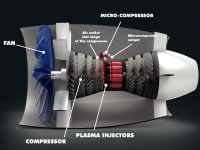ECOLOGICAL JET ENGINE is a patented propulsion innovation that converts conventional Brayton-cycle turbines into fully electric, zero-emission systems using advanced plasma technology. Designed for both retrofitting existing turbines and powering next-generation electric aircraft engines, this system delivers a transformative solution for sustainable aviation and energy production.
How it Works
The system maintains the fundamental architecture of the Brayton cycle—air compression, heating, expansion, and exhaust—but replaces the traditional combustion chamber with a high-temperature plasma chamber. The process operates as follows:
- An advanced microcompressor diverts ~1% of the compressed air and increases its pressure at a 4:1 ratio.
- This high-pressure air is injected into patented plasma nozzles equipped with an anode and cathode energized by a 40,000 V potential difference, generating a stable arc of plasma.
- The plasma reaches temperatures up to 10,000 °C and transfers heat to the main airflow, raising it to the turbine’s optimal inlet temperature (~720 °C).
- The heated air then enters the turbine for expansion and power generation, following the standard Brayton cycle.
The injector design is customized to turbine parameters such as mass flow, pressure ratio, bypass ratio, and turbine inlet temperature (TIT), ensuring system compatibility and efficiency preservation.
Energy Supply and Weight Consideration
In conventional jet aircraft, fuel can represent up to 30–35% of the aircraft's takeoff weight. For instance, a Boeing 737-800 typically carries up to 45,000 pounds of jet fuel (approximately 20,400 kg) for long-range operations. With ECOLOGICAL JET ENGINE, this fuel weight is effectively replaced by electric energy storage systems—such as high-density battery packs—maintaining a similar overall mass balance. This substitution enables full electrification without compromising aircraft performance, particularly in short- and medium-haul applications.
Innovation:
This technology represents a major advancement over current combustion-based systems by:
- Maintains the Brayton cycle architecture, enabling direct retrofit in existing turbines without redesigning the compressor-turbine core.
- Replaces the combustion chamber with a high-voltage plasma chamber (up to 40,000 V), achieving thermal input without chemical combustion.
- Uses microcompressor-fed plasma injectors that deliver high-pressure air (~1% of total flow, compressed at a 4:1 ratio) for efficient arc stabilization and plasma generatio
Manufacturability and Feasibility:
ECOLOGICAL JET ENGINE is designed for cost-effective scalability and integration:
- It can be installed in existing turbines such as the Rolls-Royce Tay 611c without major modifications.
- All core components (plasma injectors, microcompressor, control valves) can be manufactured with established aerospace-grade materials and processes.
- It has been developed over a five-year R&D cycle by a turbine specialist.
Applications and Marketability
- Commercial aviation: retrofitting narrow-body aircraft like Boeing 737 or Airbus A320.
- Private and business jets: enabling cleaner, high-efficiency electric propulsion.
- Military aviation: offering electrification for tactical aircraft with enhanced energy autonomy.
- Power generation: adapting Brayton-cycle turbines in stationary power plants to run without fossil fuels.
ECOLOGICAL JET ENGINE is protected under international PCT patent status, ensuring global recognition, priority rights, and the ability to license or commercialize the technology in over 157 countries.
Video
Like this entry?
-
About the Entrant
- Name:Luis Felipe De Freitas Romero
- Type of entry:individual








